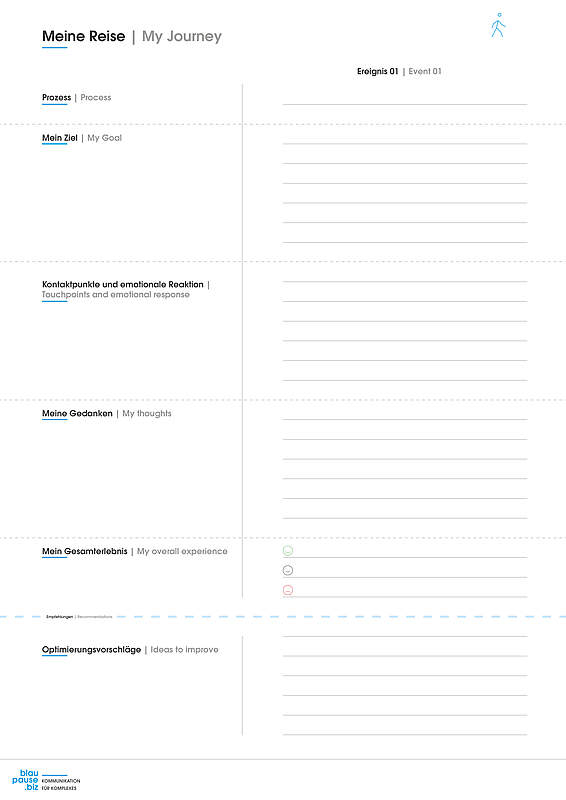Design Thinking Methods - Part 2: Customer Journey
In our series "Design Thinking for your B2B Marketing", we introduce you to helpful tools that support you in your strategic marketing.Today we are talking about the Customer Journey, which helps you to define and, if necessary, improve the touchpoints between your company and your customers.
Design thinking is a creative approach to solving problems and developing new ideas from a customer perspective. Use the agile methods of this way of working to move your B2B marketing forward.
Acquiring new customers is often a difficult and time-consuming matter. Especially when it comes to expensive capital goods, the decision-making process on the customer side can take a lot of time. Potential customers come into contact with your company in many different ways at different times before actually becoming your customer. To win over new customers, the experience with your company should be as optimal as possible - at any time through any channel. But where do your potential customers meet you in the first place and what is their experience?
1. What is a Customer Journey Map and what do I them?
The Customer Journey Map is a design thinking tool and describes the customer's "journey" from the initial contact with the product/service to conversion or firm commitment to the company. This journey runs through several touchpoints between the customer and your company. These include TV commercials, trade fair appearances, mailings, phone calls, etc. With a customer journey, you ask what happens at these touchpoints and what is going on in your customer's mind.
Reflecting on this customer experience not only helps you to optimise your processes, but also your staff's behaviour towards customers. When a customer contacts you with a complaint, they don't want to wait days for an answer, nor do they want to hear "That can't be!". So the goal is to formulate suggestions on how you can optimise the customer experience across all touchpoints - because there are no second chances for first impressions and every negative experience affects your image.
2. How create I create a Customer Journey?
Typically, a customer journey is divided into Awareness, Consideration, Acquisition/Conversion, Retention and Advocacy phases. However, you can also create a customer journey for only one of these phases. How you proceed afterwards is (almost) entirely up to you - you will find a multitude of templates on the internet, some of which are very different. We have summarised for you the elements that are particularly relevant in our experience:
- Goal
First of all, the customer's wish must be defined. What is it all about? - Touchpoints
Where does your customer meet your company? Try to include all touchpoints, even those that cannot be tracked (especially offline media such as posters, mailings, etc.). What happens at these touchpoints? What is your customer trying to achieve when he/she contacts you? Is he/she specifically looking for you or just stumbling across your offer? - Thoughts, feelings, concerns
What does your customer think about when he comes across your company or comes into contact with you? What feelings does he have when thinking about your brand? What frustrations might arise from the contact? - Overall experience
Is your customer satisfied with his/her experience? What is he/she happy or unhappy about and how does this affect the future relationship between him/her and your company? - Optimisation suggestions
What can you and your team improve to guarantee the greatest possible satisfaction of your customers across all touchpoints?

3. How edit I a Customer Journey?
As already mentioned, you do not necessarily have to work through all phases of the customer journey: If you are only interested in how your company deals with complaints, it is sufficient to concentrate on this part of the journey for the time being. Of course, it is advisable to look at the overall situation. The more tangible data, the better. Nowadays, the results of online marketing measures can be easily tracked using automated tools. This is hardly possible with offline measures, but they should still be included in your considerations ("Is the poster worthwhile at this location?", etc.).
If you have concrete data, you should definitely use it. However, the customer journey map can also be worked on without precise key figures. Make sure that the staff members who work at and with the touchpoints are present and can thus assess the customer's experience at the respective point particularly well.
4. Conclusion: Good customer experiences are decisive for your business success
By asking yourself how direct and indirect communication with your customers takes place and how it is perceived, you can uncover and correct possible weaknesses. This keeps you closer to your customers and improves their experience with your company, which ultimately gives you a competitive advantage.
You can read more about the background of Design Thinking and the Canvas tool here. In the coming weeks, we will tell you more about Design Thinking and the many effective tools that are indispensable in agile work processes! Stay tuned!

Marie Great
The strategy and creative teams at Blaupause are passionate about creating relevant and creative content for our B2B blog. Do you have a topic related to B2B marketing, innovation management, employer branding, etc. that you'd like to learn more about? Bring it on!

